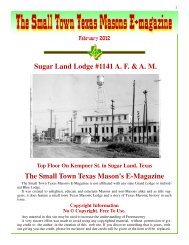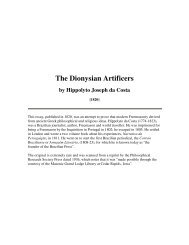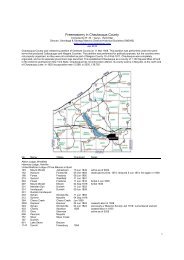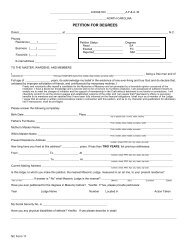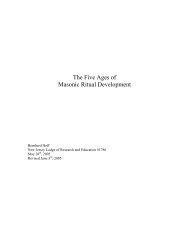1 PETER STUART NEY FREEMASON, MARSHAL OF NAPOLEON ...
1 PETER STUART NEY FREEMASON, MARSHAL OF NAPOLEON ...
1 PETER STUART NEY FREEMASON, MARSHAL OF NAPOLEON ...
You also want an ePaper? Increase the reach of your titles
YUMPU automatically turns print PDFs into web optimized ePapers that Google loves.
1<br />
<strong>PETER</strong> <strong>STUART</strong> <strong>NEY</strong><br />
<strong>FREEMASON</strong>, <strong>MARSHAL</strong> <strong>OF</strong> <strong>NAPOLEON</strong>?<br />
Thomas W. Gregory<br />
It is a cold December day and a mist hangs in the air. Soon the morning peace of<br />
the Luxembourg Palace Gardens will be broken by the guns of a military firing squad.<br />
Two columns of soldiers enter through the garden gate to take their assigned positions.<br />
Their commander, General Victor Rochechouart, looks on. His aide, Colonel Auguste La<br />
Rochejacquelein, stands by his side.<br />
They watch in silence as the soldiers march to a high wall, turn, and mark off<br />
twelve paces. The men are ordered to stand at ease, waiting to complete their<br />
assignment; to bring to a finale the illustrious - some would say, infamous career of Field<br />
Marshal Michel Ney, convicted of high treason against the French state and its Bourbon<br />
king, Louis XVIII.<br />
The light rain and an abrupt change in the location of the execution kept visitors<br />
to the garden to a minimum, although a number of soldiers watched the proceedings from<br />
the iron railing separating the garden from the street. The few civilians out at about 9:00<br />
A.M. on this cold morning no doubt had their curiosity aroused by the soldier’s presence.<br />
The civilians cluster in small groups eager to find out what is going on. A priest is<br />
spotted kneeling by an empty stretcher. Then, a soldier with a sergeant’s voice<br />
commands silence. A man in a dark suit enters the garden from a doorway and strides<br />
down a sidewalk lined with soldiers.<br />
The command is given, “Present arms. “ The man returns the salute, walks over<br />
to the officer in charge and speaks briefly with him. Major de Saint Bias nods his head,<br />
yes. The dark suited man moves to the wall, turns, and faces the two rows of<br />
executioners. He takes three paces forward and raises his hand.<br />
In a low voice Major de Saint Bias gives the orders, “Ready. Aim.” Just then the<br />
man in the dark coat commands, “ Fire! “bringing his hand down sharply on his chest.<br />
Muskets crack loudly. A large cloud of smoke fills the garden. The man falls forward<br />
and lays face down, blood spilling onto the cobblestone courtyard of the garden.<br />
“They’ve killed Marshal Ney! “a spectator cries out. “Yes, that was Ney, “says<br />
another Field Marshal Ney, who once boasted he would personally deliver Napoleon in<br />
an iron cage, lay face down, the ground around him stained blood red The soldiers march<br />
off quickly without the usual coup de grace - the customary ending to all French military<br />
executions.<br />
An old soldier in the crowd watches intently. Something is wrong here, he thinks<br />
to himself. And, from such close range, why did Marshal Ney fall forward? Surely the
2<br />
force of twelve muskets fired from no more than thirty feet away would have propelled<br />
him backward, up against the high wall. Yes, indeed, something is very strange here.<br />
Ney’s body is placed on a stretcher and covered, then hurried to a waiting carriage<br />
nearby. By now the crowd begins to disperse. Others besides the old soldier begin to ask<br />
questions, and rumors begin to circulate. Yet the official report indicates that all twelve<br />
rounds found their mark. The King accepts the official report of Ney’s execution, but a<br />
growing number of others do not.<br />
Ney’s body lay in a hospital all day until about six o’clock the next morning,<br />
when it was with much secrecy conveyed to the cemetery. Ney’s wife, thirteen years his<br />
junior, and a most beautiful and accomplished woman, loved him with a deathless<br />
affection. Yet his wife was not present when the body of her husband was taken there.<br />
The mystery which began on December 7, 1815 has puzzled and intrigued<br />
professional and amateur historians for more than a century and three quarters. Was Ney<br />
executed that morning or was his life saved as the result of Masonic and Rosicrucian<br />
brothers who staged the faked execution and helped him escape to the United States<br />
aboard the Lagonier?<br />
To understand how Ney had become such an enemy to King Louis XVII of<br />
France, we must go back two years to the 14th of April, 1814, when Napoleon was exiled<br />
to the island of Elba, leaving the French Throne open. On May 3, 1814, King Louis, with<br />
considerable aid from Britain, returned to France to resume his reign, although he was not<br />
well accepted by the French citizenry. His stay was a rather brief one. Within a year, on<br />
February 26, 1815, Napoleon set sail from Elba with six ships and volunteers from the<br />
Old Guard and a squadron of Polish Lancers of the Guard. He had been allowed to keep<br />
this small army on Elba and now used this small army to invade the southeast of France.<br />
The garrison at Grenoble fell without a shot being fired as soldiers rallied to Napoleon’s<br />
side. His growing strength sent fear into the royal salons of Paris, causing Louis to grow<br />
increasingly nervous. Louis had no choice but to rely on Napoleon’s former Field<br />
Marshals, inherited by the Crown after Napoleon’s abdication. He could not be certain of<br />
their loyalty; however they were the only military leaders of consequence he had<br />
available. Ney was summoned and in an audience with the King, made a personal<br />
promise to bring Napoleon back in an iron cage.<br />
A crucial moment came on March 14th when the two armies met. The two armies<br />
stood in silence for what seemed to be an eternity when Napoleon appeared in the front<br />
ranks. Upon seeing him the forces under Ney broke ranks, shouting “Vive l’Emperor!”<br />
as they rushed to embrace their comrades in the opposing line. Napoleon and Ney met<br />
and struck up a conversation in which Napoleon asked his old Field Marshal, “the bravest<br />
of the brave to join him”. Ney accepted and the entire force advanced toward Paris. The<br />
King fled to Belgium as the army advanced and remained until news of Waterloo and the<br />
retreat of the French army reached him some one hundred days later.<br />
A “traitors list “of eighty four names was made which included Napoleon’s<br />
Generals, Marshals, and others who sided with his cause. At the top of the list was Ney,
3<br />
who had promised to parade Napoleon through the streets of Paris in a cage. A public<br />
purge of all Napoleonic influences would be needed to keep at bay the various German<br />
Confederation states, Austria - Hungary, Britain, Spain, and the kingdoms of Italy and<br />
Naples.<br />
The Chamber of Peers found Ney guilty of treason and sentenced him to be<br />
executed by firing squad on December 7, 1815. During his trial, Ney refused an<br />
opportunity to go free as his birthplace had come under Prussian rule, and he could have<br />
claimed the protection of international law. Instead, he rose to his feet and declared<br />
“Yes, I am French - I will die French”. Word spread quickly throughout Paris that<br />
Marshal Ney was to be shot.<br />
In a last minute effort to publicly save Ney’s life, the Duke of Wellington decided<br />
to interrupt the King’s dinner party at the palace on Saturday, December 2. The only talk<br />
that evening was about the pending execution of Marshal Ney. Ultra royalists were loud<br />
in commendation of Ney’s death sentence for treason. Amidst the revelry, a carriage<br />
carrying the Duke of Wellington pulled up to the palace. He soon entered the palace with<br />
an aide and bullied his way past several guards. The King turned his back to Wellington<br />
and began speaking to several guests. After a conversation with Comte d’Artois<br />
regarding the release of Ney, Wellington left the palace in a rage. There are those who<br />
believe that Wellington tried to intervene to prevent a riot between Ultra loyalists and<br />
Republicans as word spread of Ney’s fate. There is evidence that Madame Ney reached<br />
out to Wellington for help prior to the court-martial, trial, and execution. This comes<br />
from a report by Corlyer Farrington, dated September 1920, from a Masonic Lodge in<br />
San Francisco.<br />
Did Wellington respond to this appeal? In his book, “Marshal Ney : a Dual Life”,<br />
Legette Blythe states that Wellington had intervened, his being a Freemason, a member<br />
of a lodge in County Meath in Ireland. Dr. Edward J. Smoot, author of “Marshal Ney,<br />
before and After Execution”, states “I believe that Wellington saved Ney’s life, and in all<br />
probability, did not wish to intervene publicly. A mock execution would serve his<br />
purposes, everything considered, and Ney at the same time, would be sufficiently<br />
punished.”<br />
King Louis decided to send the man he trusted most, Charles Talleyrand-Perigord,<br />
to Vienna for the peace conference, while at home the arrests and trials began in earnest.<br />
Talleyrand served as an ambassador and as Minister of Foreign Affairs. He<br />
helped form the provisional government but by late 1815 was forced to resign due to the<br />
hostility of the Bourbon nobility. Talleyrand was a Freemason, a member of Nine<br />
Sisters Lodge in Paris, the same lodge as many of Napoleon’s Generals, including<br />
Marshal Ney. Talleyrand and Wellington had met on many occasions and were cordial<br />
friends. Talleyrand had much to do before heading to Vienna. Growing concern for<br />
Napoleon’s officers and their families prompted a secret mission while he visited<br />
England to secure cordial relations between the two former enemies. Talleyrand did all<br />
he could to secure cooperation in the escape and subsequent safe passage for French
4<br />
officers to Quebec, Britain’s French - speaking province in North America. He was<br />
unsuccessful as George IV refused any official participation in such a plan. Another way<br />
would have to be found to save Marshal Ney and the others.<br />
Within a few days of returning to France from Britain, Talleyrand boarded a ship<br />
for America. While in Philadelphia he visited the grave of Benjamin Franklin to pay his<br />
respects. The time had finally come for repayment of a debt involving Franklin’s fellow<br />
Masons of St. John’s Lodge in Philadelphia. During Franklin’s nine year stay in France,<br />
as the first U.S. ambassador to France, and became very popular with the French people.<br />
He was active in Nine Sisters Lodge, where arrangements had been worked out in private<br />
for military assistance during the War of Independence. The Masonic kindness<br />
experienced by Franklin many years before would now be reciprocated in Philadelphia.<br />
And so, with the assistance of St. John’s Lodge members, numerous French military<br />
officers would be helped to enter the United States at Baltimore and Philadelphia. Then<br />
they would disappear into the countryside, most likely in the French - speaking areas of<br />
South Carolina and Louisiana.<br />
In January, 1816, a man who gave his name as Peter Stuart Ney landed at<br />
Charleston, South Carolina. Some French refugees reported that they saw Peter Stuart<br />
Ney at Georgetown in 1819 and recognized him as Marshal Ney. As soon as Ney heard<br />
this he left Georgetown. He taught school in Brownsville, South Carolina in 1821. He<br />
then went to Mocksville, North Carolina and taught there and in other North Carolina<br />
towns including Hillsborough, Salisbury, and Third Creek until 1828.<br />
Peter Stuart Ney’s decision to settle in rural North Carolina suggests he may have<br />
been looking for a low profile existence in America. He eventually made his way into<br />
Virginia where he taught at Abbeyville, in Mechlenburg County.<br />
While he was in the Third Creek area, he was a frequent visitor to the large parklike<br />
yard of the church where he would watch the local militiamen drill. On occasion, he<br />
would show young officers how to use a sword and would drill and run through<br />
maneuvers with them in a way far superior to their own officers.<br />
On a particular day at the green, Ney took an officer’s sword and made mention<br />
that a good sword should bend double. Upon attempting this with the sword, he broke it,<br />
which enraged the officer so, he wanted to fight. Ney picked up a large stick and<br />
declared “You find another sword and I’ll use this stick to teach you a lesson in<br />
manners.” The officer declined Ney’s invitation.<br />
There are a number of stories that can be recounted concerning Ney as he taught<br />
in the Iredell, Rowan, and Davie County areas. Some of these have spurred the legend of<br />
Peter Stuart Ney as Marshal Ney of France, and I will proceed to recount a few of them.<br />
A man named William Sidney Stevenson of Statesville, North Carolina knew<br />
Peter Stuart Ney and in 1840 attended a political meeting in Rowe’s Township, about<br />
nine miles from Statesville. Mr. Stevenson was in the company of Frederick Barr, a
5<br />
German who had served for years under Ney, when Peter Stuart Ney and Col.<br />
Thomas Allison walked past them on the opposite side of the road. Barr exclaimed<br />
“Why, there is Marshal Ney. They told me he was shot; but he was not. Yonder he is. I<br />
know him, for I fought for him off and on for six years in Napoleon’s wars.” A short<br />
time after the political meeting, Barr moved to Indiana.<br />
A fencing master came to the Third Creek area and Ney’s students asked their<br />
teacher to joust a bit with the fencing master. Though several years his senior, Ney<br />
disarmed the master, who left telling the students they already had a master.<br />
His body was covered with scars which were said to be of such magnitude that<br />
they had a ghastly effect on those who saw them. They appeared to be old wounds from<br />
gunshots and shrapnel.<br />
Ney had a habit of drinking a bit too much from time to time, and when under the<br />
influence, he would declare that he indeed was Marshal Ney of France. He made claims<br />
that he could cut off a man’s head with a single blow of his sword and that his steed was<br />
trained to run to the cannon’s mouth. Rev. R.A. Wood of Statesville 1840: “Ney had but<br />
one vice, occasionally drinking to excess, but his general conduct was so pure, when<br />
sober or drunk, and was always absolutely consistent<br />
When Ney taught school, his habit was to arrive early at the schoolhouse so he<br />
could spend some time alone reading the newspaper. One morning in 1821, his placid<br />
existence suffered an abrupt interruption.<br />
On that morning, after noticing a shocking front page story, Ney passed out and<br />
was discovered by students arriving for school. They aroused him, and still in a state of<br />
shock, he canceled classes for the day. John Rogers, one of Ney’s students, and a<br />
member of the family with which he was living in Florence, S.C., gave him a ride home<br />
and while riding along the country road, Ney told him the news; the Emperor Napoleon<br />
was dead. He had died on May 5, 1821 on the island of St. Helena.<br />
Ney attempted suicide that evening by slitting his own throat. He was discovered<br />
by family members of the home in which he boarded and attended by a local physician,<br />
he recovered. After his strength returned, he spoke about the incident to John Rogers and<br />
told him he had hopes of returning to France, but those hopes were shattered now that<br />
Napoleon was gone.<br />
The St. Louis Republic of 1891 gives a bit of interesting information. It states<br />
that during the reign of King Louis Philippe, Mr. George Melody, of St. Louis, spent<br />
several weeks in Paris. Some years before this the King had been entertained by Mr.<br />
Melody in St. Louis. Melody asked the King about whether Ney had been executed. The<br />
King replied that he was among the most recognized Freemasons in Europe and that<br />
Melody was as well known in Freemasonry in America, and that Ney held a position in<br />
Masonry as high as either of them, - another man may have filled the grave intended for<br />
Ney.
6<br />
Rev. Basil Jones of South Carolina said that Ney told him he fell by concerted<br />
arrangement, the Ancient Fraternity aiding in his escape. A bladder of red dye was<br />
smuggled into his cell as he awaited execution and was broken against his chest as he<br />
brought down his right hand with the order “fire!” The muskets were loaded with<br />
blanks, and Ney fell forward as they fired.<br />
According to C.W. Allison, author of “Ney, The Great French Soldier”, Ney was<br />
an active Rosicrucian and during his time in France used his own funds and those of<br />
acquaintances for the building of a Rosicrucian Temple and Lodge room in Paris. Since<br />
there were a number of Rosicrucians, not only in Napoleon’s army, but on both sides, and<br />
in many parts of France, descending from the ancient order of Rosicrucians and Knights<br />
of the Temple (not the modern Knights of the Temple) we may understand how it came<br />
to be that Ney perhaps was not executed on December 7, 1815, as generally recorded.<br />
According to Mr. Allison, Peter Stuart Ney made a number of visits to the Rosicrucian<br />
headquarters in Fairmont Park, Pennsylvania, and later at Ephrata, Pennsylvania, ruins of<br />
which buildings still remained in 1946 when Allison authored his book.<br />
Ney lived and taught in several communities where Masonic Lodges were<br />
located. To date, we have found no record of Peter Stuart Ney attending any of these<br />
Lodges. We know he enjoyed the company of Masons in the Statesville, Mocksville, and<br />
Salisbury areas, but as yet, we have no record of his being an active Freemason while in<br />
the United States.<br />
On his deathbed, the 77 year old Ney was asked by his doctor if he was indeed the<br />
French general whom Napoleon called “the bravest of the brave.” He raised himself on<br />
one elbow and declared: “By all that is holy, I am Marshal Ney of France!”<br />
For over a century and a half, scholars, residents, and visitors have made their<br />
way to his grave at Third Creek Presbyterian Church near Cleveland, North Carolina.<br />
The real Marshall Ney, the skeptics maintain, is buried in Paris. His tomb is in<br />
the Pere La Chaise Cemetery, as is the statue of Ney in Montparnesse that American<br />
Author Ernest Hemingway wrote about in “The Sun Also Rises.” If Ney really wanted to<br />
disappear into the countryside, why didn’t he change his last name? Perhaps he wanted<br />
to hold onto a bit of his past life, evidenced by his confessions to acquaintances that he<br />
was indeed Marshal Ney and that he had little to fear here in the United States.<br />
Raymond Horricks, author of “In Flight With The Eagle”, noted that one of Ney’s<br />
sons challenged Wellington to a duel for not assisting his Father to escape. The duel<br />
never took place. Horricks wonders why Wellington did not intervene - or did he?<br />
I don’t think we’ll ever know the truth about Peter Stuart Ney. Perhaps his story<br />
is a legend and nothing more. Nonetheless, it is a fascinating story that somehow seems<br />
all the more believable to Masons. We have all heard countless stories of selfless acts of<br />
courage and compassion that have occurred between members of our craft, particularly
7<br />
during times of upheaval and war. Legend or not, believers from all over the world travel<br />
to the rural graveyard off a winding country road in Rowan County, North Carolina to get<br />
a glimpse of Ney’s tomb. A small French flag flies at the head of the grave. The<br />
inscription on the tomb does nothing to diminish the legend: “In memory of Peter Stuart<br />
Ney, a native of France and soldier of the French Revolution under Napoleon Bonaparte,<br />
who departed this life November 15, 1846, aged 77 years.”<br />
______________________<br />
Napoleon’s Traitor. Toby Giese, New York 1989.<br />
Ibid. p. 10<br />
Ibid. p. 13<br />
Ibid. p. 14<br />
Napoleon’s Marshal - The Life of Marshal Ney. John Foster, New York 1968.<br />
Marshal Ney, A Dual Life. Legette Blythe, New York 1937<br />
Ibid. p. 204-206<br />
Ibid. p. 213<br />
Marshal Ney, Before and After Execution. D. J. Edward Smoot, Charlotte 1929


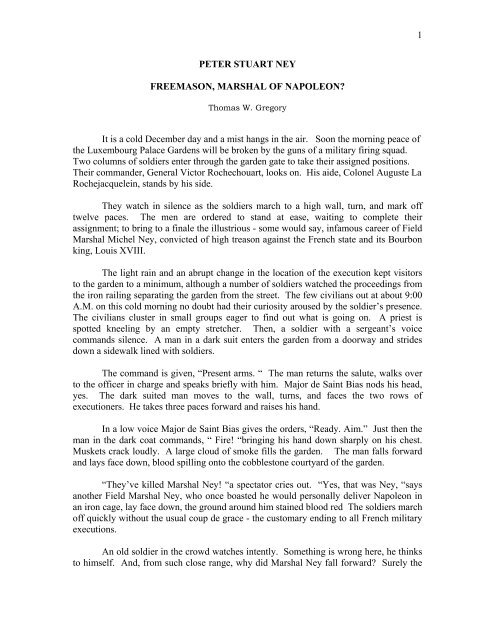
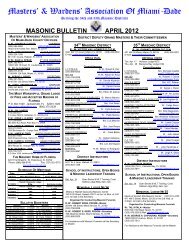
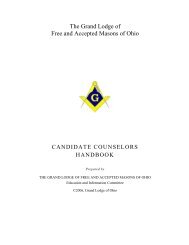
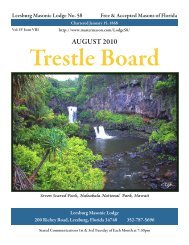

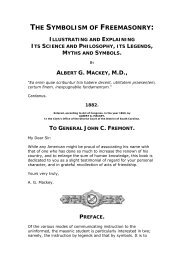

![Junior Grand Warden Views [2005-2] - MasterMason.com](https://img.yumpu.com/36303049/1/190x245/junior-grand-warden-views-2005-2-mastermasoncom.jpg?quality=85)

